Decorative lighting of premises and individual sections of street spaces is organized in a variety of ways. One of them is the use of modern LED strips operating from reduced voltages (12 and 24 Volts). The effectiveness of their application depends on the correct choice of the model and the characteristics of a particular product, mounted in the right place. To connect them to a power supply unit (PSU), you will need to take into account the type of backlight, total power consumption, as well as the necessary margin for this parameter.
Description, principle of operation and design of LED strip

LED strips are flexible printed circuit boards with equally spaced semiconductor elements. They also carry miniature resistors to limit the current flowing through the semiconductors. These products are manufactured using the well-known SMD and DIP technologies. The first of them is the most common in the field of interior lighting, since it involves surface mounting of lighting elements.
The abbreviation for each of them indicates the type and size of the semiconductor. Marking SMD 3528, for example, corresponds to an electronic crystal with working dimensions of 3.5 and 2.8 mm. The width of the strip base is 0.8-2.0 cm, and its thickness, together with the diodes, is 0.2-0.3 cm.
The operation of strip lighting elements is based on the principle of sequential connection of point sources (LEDs) into a loop of the required length. In the simplest products in monochrome design, the ribbons include elements of the same type, which are powered from a special unit.
The supply voltage of LED strips is usually no more than 12 volts.
Understanding the principle of operation will help familiarity with the device of this flexible lighting product.
Design
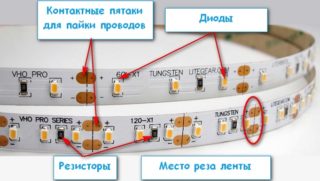
The design and circuit of the 12 Volt LED strip are distinguished by their simplicity and reliability, since they contain only a few elements. They include the LEDs themselves, connected by a loop in the form of a ribbon chain, and limiting resistors per 3 diodes. Copper contact pads are provided every three elements, used if a piece of the desired length is cut from the roll at this point. When connecting LED products, it is imperative to observe the polarity indicated on the side of the ribbon along with the designation of the supply voltage.
In more complex and attractive designs, tricolor LED products are used, allowing to obtain original combinations of the main spectral colors (red, blue and green). To control their combinations, special electronic devices are used - controllers.
Advantages and disadvantages
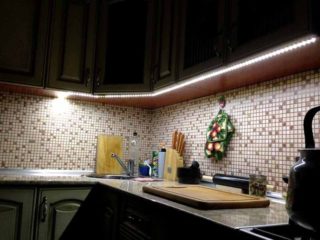
The advantages and disadvantages of LED strips should be considered with reference to their purpose and type. For monochrome products, most often used as illumination of limited areas or hard-to-reach places, the advantages declared by the manufacturer are expressed in the following:
- low power consumption;
- small size of the tape, which almost does not take up space in the working area;
- the ability to adjust the illumination by changing the total length of the loop;
- relatively low cost excluding the power supply.
Some of the advantages are achieved at the expense of limitations inherent in other indicators. The small size, in particular, is the reason for poor lighting. The need for a reduced voltage leads to additional costs for the purchase of a power supply unit or a powerful current source. The same is observed with three-color decorative ribbons, when the high cost of an RGB controller or a special network module has to be paid for the positive effect of the play of colors.
Power supplies for LED strips 12 Volt
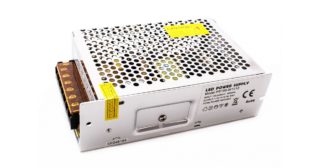
Traditionally, branded power supplies designed specifically for these purposes are used as power supplies for 12 Volt LED strips. A number of domestic and foreign manufacturers have developed a whole line of devices similar in design, differing only in output power.
All of these models are designed to include a different number of monochrome LED elements (ribbons of different lengths).
For 12 Volt LED strips, power per meter of length is the main parameter that determines their choice for specific purposes. Its value depends on the number and type of LEDs used in the strip. For SMD 3528 products, for example, 60 diodes placed on one meter consume a total power of 4.8 watts. It follows that 24 watts are required to operate a 5-meter tape with LEDs of this type. Since the power supply unit is always selected with a small margin, in this case a power supply device with a declared power of about 32 watts is suitable. Taking into account these features of the choice of the desired indicator, its maximum value can reach hundreds of watts or more.
Applications of LED strips
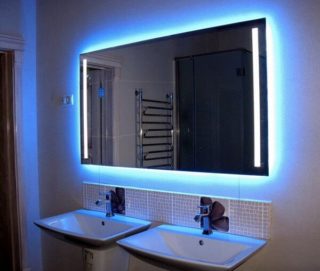
The main function of LED devices is the organization of artificial lighting in a specific room or outside the building. In this case, the LED strip replaces conventional bulbs, located along the perimeter of the ceiling or in a pre-marked area. Such an approach to decorating free spaces allows improving the quality of the light pattern and evenly illuminating the serviced objects. Thanks to this, it is possible to increase the comfort of people in places of rest or in the work area.
Usually, for these purposes, tapes with elements of increased brightness are used, characterized by a warm white glow. The use of low-power lighting devices, even if they are evenly distributed around the entire perimeter, will require the installation of an additional lamp.
In some cases, a deviation from the main profile is possible. This applies to the situation where the elements included in the lighting strip are suitable for installation in car headlights.
Decorative use
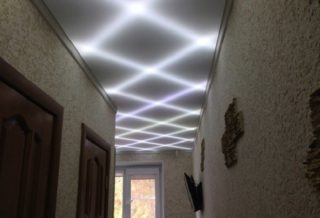
Modern LED lighting devices are very popular in decoration practice and are widely used in the following areas:
- lighting of shelves, building niches and stairs;
- architectural zoning of workspaces;
- highlighting elements of landscape zones, with existing flower beds and trees;
- decoration of building facades, as well as individual architectural details.
In addition, they resort to their help when it is necessary to focus on the elements of the environment: furniture, mirrors, paintings and other objects. To meet the constant demand, manufacturers have developed many varieties of LED strips, which provide various visual effects.
One of the possible uses of led products is for marketing purposes. The originality of the performance of three-color LED devices helps to attract the attention of a potential buyer. They are widely used in the design of the interior spaces of sales areas, as well as advertising structures placed on the street.








